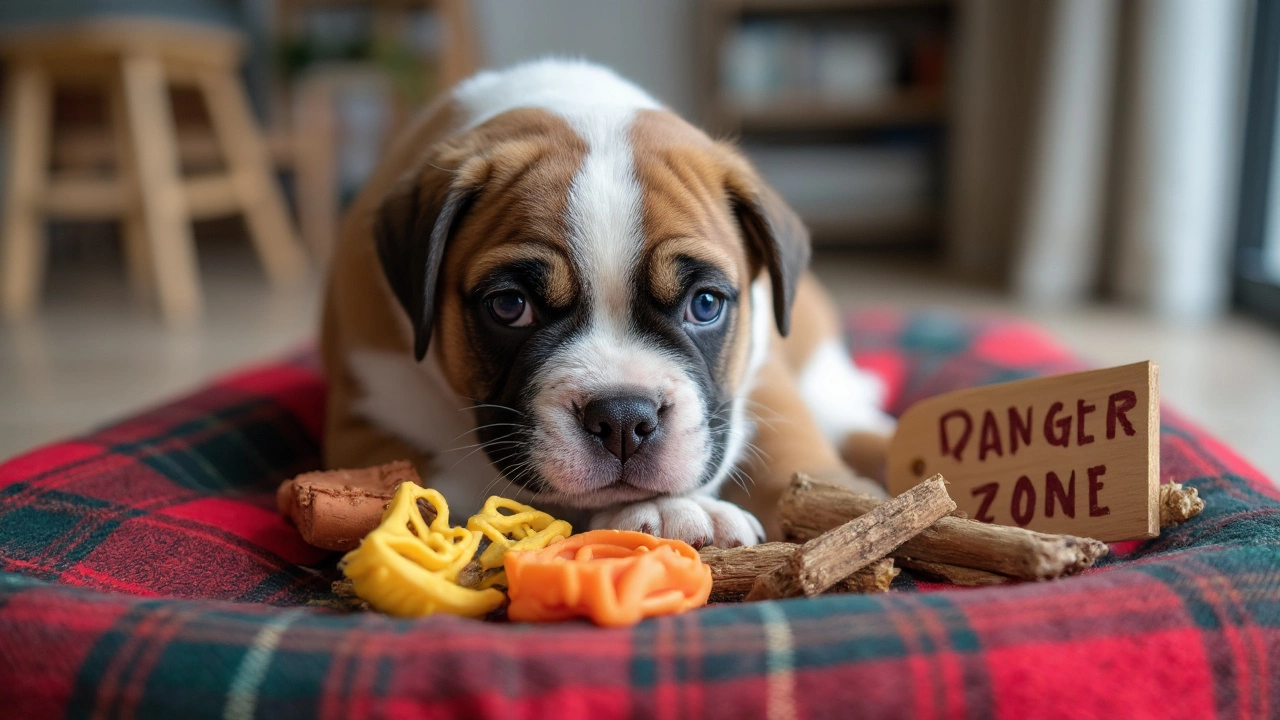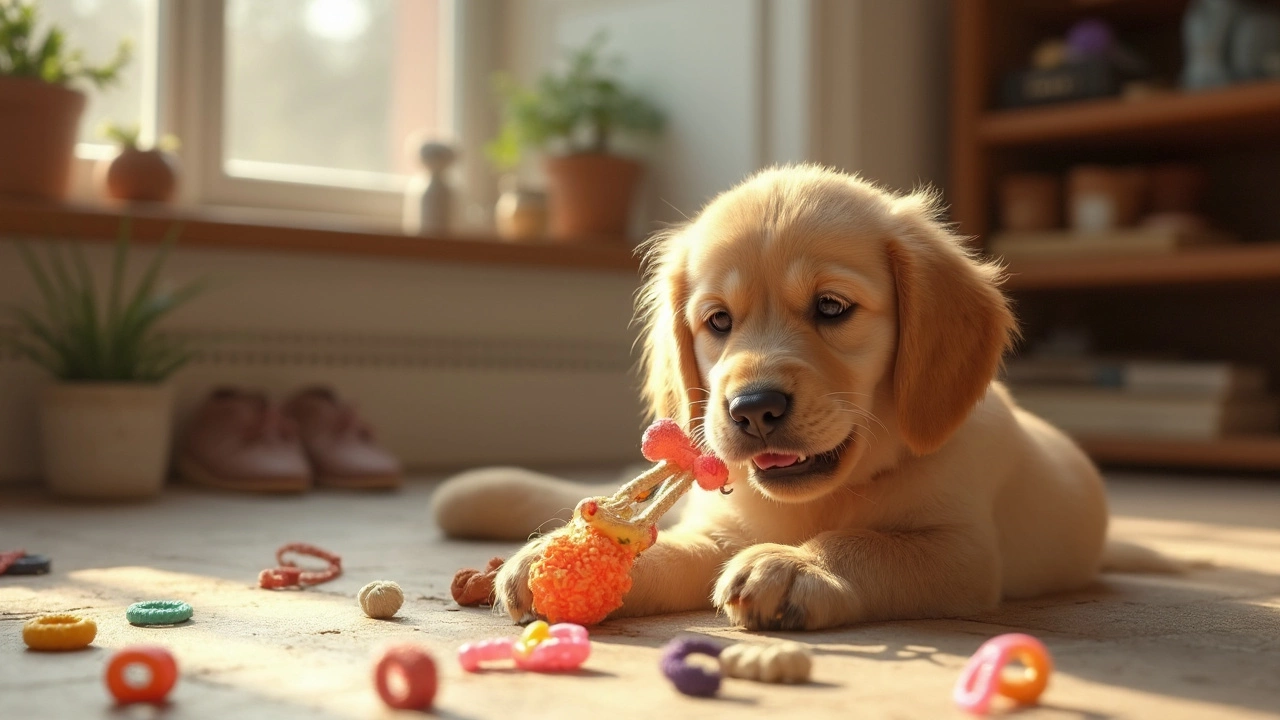You set down your brand new puppy and within minutes, she’s on a mission to taste absolutely everything. Shoes. Socks. Table legs. There’s a good reason for that—8 week old puppies are in the thick of teething. Their tiny teeth are razor sharp and their gums are sore, so chewing feels soothing. But not everything in your house is safe to chew, and picking the right toys now can actually shape her habits later on.
So what actually works? Soft rubber toys made for puppies are a lifesaver. They’re gentle enough for baby teeth, but tough enough not to shred into pieces. Rope toys can be okay, just make sure they’re made for puppies and don’t fray easily. I’ve had luck with puppy-sized Nylabones too—those small, flexible ones made for teething are way safer than the adult size. Even a wet, chilled washcloth (supervised, of course) can help soothe sore gums. It doesn’t have to be fancy, just safe and easy for tiny mouths to grab!
- What Teething Puppies Really Need
- Safe Chew Toys That Actually Work
- What to Avoid: Common Chew Hazards
- Tips for Happy, Healthy Chewing
What Teething Puppies Really Need
Puppies at 8 weeks are deep in the teething zone. Their baby teeth (or deciduous teeth) are still coming in or already showing. Most puppies will get all 28 baby teeth by the time they are about 8 weeks, and these little daggers hurt! As their mouths change, chewing gives major relief. But stuffing any random object in their mouth? That’s risky—not all household items or toys are puppy-safe.
What you want is a mix of comfort, safety, and engagement. Puppies don’t just chew to feel better—they also use their mouth to explore. Besides, building positive chewing habits now means less trouble as they get older. If you give your puppy the right chew items now, you’re less likely to end up with holes in your sneakers or bite marks on your TV remote later.
- 8 week old puppy teeth are sharp but still delicate—hard toys can fracture them.
- Chewing helps relieve gum pain but also fights boredom and keeps your pup busy.
- Start introducing textures early—soft rubber, gentle rope, and even cold washcloths help them learn what’s okay to chew.
- Always pick toys labeled for puppies, not adult dogs. Puppy toys bend easily and won’t hurt fragile jaws.
- The right toys help with mental development, too. Chew toys for puppies are often brightly colored and easy to carry around, which makes them way more fun and less likely to be ignored.
Some brands put age ranges right on the packaging, making it easy to grab what works for 8-week-olds. Avoid toys that break apart or have small parts—they’re choking hazards. And be ready to swap things out as that puppy grows. Remember, teething isn’t forever, but the right habits last way longer.
| Need | Why It Matters | Safe Solution |
|---|---|---|
| Sore gums | Puppies bite and chew for relief from gum discomfort. | Soft rubber teething rings, chilled cloths |
| Mental stimulation | Chewing helps fight boredom and keeps pups busy. | Safe, interactive puppy toys |
| Safe textures | Right textures protect baby teeth and teach safe chewing. | Puppy-designated ropes and flexible rubber toys |
| Supervision | Prevents choking or injury from breaking toys. | Always watch playtime and swap out broken toys |
If it squeaks too loud, tears too easily, or is smaller than your puppy’s jaw, it shouldn’t go in the shopping cart. A little effort now makes your puppy’s teething days a lot less stressful for both of you.
Safe Chew Toys That Actually Work
Shopping for chew toys can feel overwhelming, especially with all the wild claims out there. The real trick is finding toys that are gentle on a puppy’s mouth, won’t break apart, and keep them busy. At 8 weeks, their mouths are tiny and their gums are sore, so one-size-fits-all toys don’t cut it. Brands mark products as “puppy safe,” but let’s get more specific about what actually works for these little chomping machines.
- 8 week old puppy teething rings: Flexible rubber rings, like the KONG Puppy Teething Ring, are designed just for puppies. They bounce a bit, which is fun, but bend so they’re gentle on baby teeth.
- Puppy-safe plush toys: Look for soft toys without squeakers or tiny parts that could come loose. GoDog and ZippyPaws have good puppy lines, just make sure to check often for rips.
- Freezable toys: Some puppy chews, like the Nylabone Chill & Chew Freezer Dog Bone, can go right in the freezer. The chill soothes gums, which is a real win during teething spurts.
- Rope toys for puppies: Opt for mini rope toys labeled for puppy use. These are softer and made with tighter weaves—regular ropes for older dogs are too rough and shred fast in puppy mouths.
"Toys made for teething puppies are usually the safest bet. They're tested for durability and designed with soft gums in mind. Adult dog toys or bones are often too hard and put puppies at risk for broken teeth or choking." – Dr. Megan Maxwell, DVM, American Veterinary Medical Association
I’ve tested well-known options at home. The KONG Puppy, for example, is my go-to. Stuff it with a bit of kibble or low-fat plain yogurt (freeze it for a bigger challenge), and you buy yourself ten whole minutes to drink your coffee. Nice bonus: these toys are dishwasher-safe.
Puppies are chewing machines. In a survey shared by the AVMA in 2024, 83% of puppy owners said their dogs chewed daily and went through at least two toys a month at this age. Here’s a quick comparison of how popular chew toys stack up when it comes to 8 week old puppies:
| Toy Type | Durability (1-5) | Safety for 8 week old puppies | Fun Factor |
|---|---|---|---|
| KONG Puppy | 5 | Very High | High |
| Plush (Puppy Line) | 2 | Medium (Monitor Closely) | High |
| Mini Rope | 3 | High | Medium |
| Freezable Chew | 4 | Very High | Medium |
When hunting for that perfect toy, keep it simple: If it bends, has no small pieces, is labeled for puppies, and is made by a trusted brand, you’re probably on the right track. And always check for wear. Even the best toy isn’t safe forever, especially with a determined chewer around.

What to Avoid: Common Chew Hazards
When your 8 week old puppy gets the urge to chew, anything within reach is fair game. But not everything she finds is safe. Getting this wrong can mean a scary trip to the vet, so let’s go over what to keep away from those puppy jaws.
Some items seem innocent until you look closer. For example, squeaky toys with loose parts can turn into choking hazards fast. Even popular tennis balls can shred, leaving behind bits of fuzz that aren’t digestible. Anything that's too hard—like real bones, antlers, or cooked meat bones—can actually break your puppy’s fragile teeth.
- Household Items: Socks, shoes, electrical cords, hair ties, and children’s toys are just asking for trouble. Puppies swallow things a lot quicker than you expect.
- Rawhide Chews: These are all over the pet store, but they’re risky. They can swell up and block a puppy’s airway or stomach, or splinter into sharp pieces.
- Stuffed Toys (Not Meant for Dogs): The stuffing inside can cause blockages if swallowed, and plastic eyes or noses can come off too easily.
- Hard Chews: Think antlers, real bones, hard nylon toys (not those marked puppy-safe). Fractured baby teeth are expensive to fix.
- Anything Small Enough to Swallow Whole: If it fits in your puppy’s mouth, assume it could go down the hatch in seconds.
Here’s a look at some stats that surprised me when I first started puppy proofing:
| Item | Common Risk | Recommended For Puppies? |
|---|---|---|
| Rawhide | Choking, blockages | No |
| Tennis balls | Fuzz buildup in stomach | No |
| Puppy-safe rubber toys | Minimal risks if right size | Yes |
| Cooked bones | Shards, broken teeth | No |
A good rule: if you couldn’t easily dent the toy with your fingernail, it’s likely too hard for a teething puppy. Always double-check labels for "puppy safe" or "for teething puppies." And when in doubt, skip it—puppies are masters at finding trouble. Supervise any new toy, and pitch it if it starts falling apart. Your shoes and your pup’s tiny teeth will thank you.
Tips for Happy, Healthy Chewing
Setting up your puppy for success with chewing is all about routine, supervision, and picking the right stuff. Here’s what’s worked for me—and what most puppy owners wish they’d known earlier.
- Supervise at all times. Eight-week-old puppies aren’t great at knowing what’s safe. If you’re close by, you’ll catch them before they try something dangerous (like your power cords or that stray sock under the couch).
- Rotate toys to keep things fresh. Puppies get bored fast. I keep a basket of 4-5 chew toys and swap them every few days. This makes old toys suddenly interesting again and keeps your puppy away from household items.
- Reinforce what’s right. If your puppy grabs a safe toy, praise them or give a gentle belly scratch. Mine learned pretty quickly that chewing her own toys led to happy voices and treats.
- Redirect, don’t punish. When your puppy bites on something forbidden, calmly swap it for a chew toy instead of scolding. It’s about rerouting that puppy energy, not making them scared to explore.
- Don’t forget the freezer trick. Chilling puppy-safe toys or a damp washcloth can calm sore gums. Just watch your puppy so she doesn’t eat the cloth!
Also, size matters. Make sure all chew toys are large enough that your puppy can’t swallow or choke on them. Here’s a handy chart to help you pick the right toy size for an 8 week old puppy:
| Weight of Puppy | Recommended Toy Size |
|---|---|
| 3-5 lbs | Extra small/puppy-specific toys |
| 6-10 lbs | Small puppy toys |
| 11-20 lbs | Medium puppy toys |
Replace chewed-up toys as soon as they start to break apart. Small parts can quickly turn into choking hazards. I’ve made this mistake and found toy pieces in places they shouldn’t be—lesson learned! By keeping things fun and safe, you’ll get through this chewy stage with less mess, fewer lost shoes, and a pup that knows what’s okay to chew.
